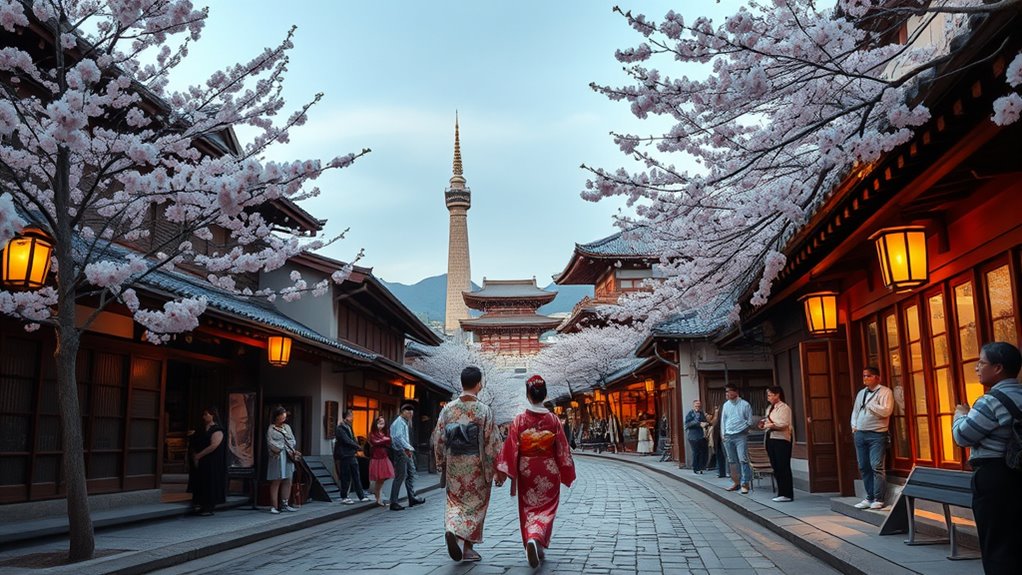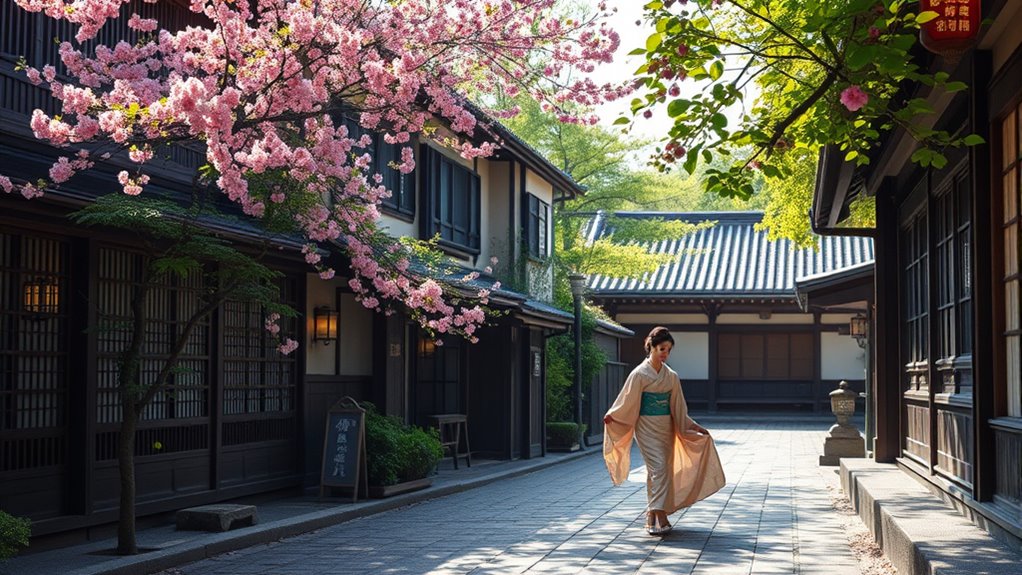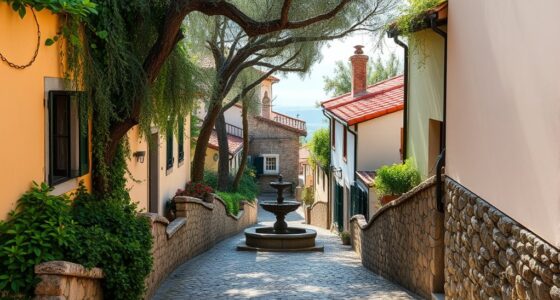Kyoto offers timeless luxury that blends rich cultural heritage with exquisite hospitality. You’ll find stunning temples like Kinkaku-ji as perfect backdrops, while traditional ryokans provide authentic experiences with onsen baths and kaiseki dining. Luxury hotels, such as Suiran and Park Hyatt, combine modern comfort with Japanese aesthetics. With a strong focus on sustainable practices, Kyoto’s luxury tourism is evolving. Discover more about what makes this city a unique destination for those seeking a luxurious escape.
Key Takeaways
- Kyoto’s luxury experiences are enriched by its stunning temples and serene Zen gardens, offering breathtaking backdrops for relaxation and contemplation.
- Traditional ryokans provide authentic hospitality, featuring tatami-matted rooms, onsen baths, and exquisite kaiseki cuisine for a unique cultural immersion.
- Luxury hotels like Suiran and Park Hyatt blend modern comforts with Japanese aesthetics, enhancing the overall guest experience with artisanal dining and cultural programs.
- Private tea ceremonies and artisan workshops connect visitors with Kyoto’s rich artistic legacy, showcasing the city’s dedication to craftsmanship and tradition.
- Sustainable luxury tourism is prioritized, with eco-friendly accommodations and community engagement initiatives to minimize environmental impact while preserving Kyoto’s heritage.
Cultural Heritage and Its Influence on Luxury

As you wander through Kyoto, you’ll quickly notice how the city’s rich cultural heritage shapes its luxury experiences. The stunning temples and shrines, like Kinkaku-ji and Fushimi Inari, provide a backdrop that enhances your journey.
Staying in a traditional ryokan, you’ll indulge in authentic hospitality, savoring exquisite kaiseki cuisine and soaking in onsen baths, all while immersing yourself in centuries of tradition.
In the Gion district, high-end tea houses and Michelin-starred restaurants reflect the elegance of geisha culture. You can also explore serene Zen gardens that invite contemplation.
With every interaction, from private tea ceremonies to artisan workshops, you’ll connect with Kyoto’s artistic legacy, making your visit not just luxurious, but profoundly enriching.
The Pinnacle of Luxury Hotels in Kyoto

Kyoto offers more than just cultural experiences; it’s also home to some of the finest luxury hotels that blend traditional Japanese elegance with modern comfort.
At Suiran, a Luxury Collection Hotel, you’ll enjoy stunning views along the Hozu River, private ‘Onsen’ baths, and exquisite dining options like Kyo-Suiran.
Experience breathtaking views of the Hozu River, private ‘Onsen’ baths, and exquisite dining at Suiran, a Luxury Collection Hotel.
Park Hyatt Kyoto showcases a unique fusion of contemporary architecture and Japanese aesthetics, featuring an open-air infinity pool and various cultural programs.
HOTEL THE MITSUI KYOTO dazzles with 160 guest rooms crafted from natural materials, alongside five dining areas emphasizing local produce.
Whether you’re indulging in artisanal cuisine or participating in a traditional tea ceremony, these hotels ensure a truly luxurious experience in the heart of Kyoto.
The Economic Impact of Tourism on Kyoto

While exploring the enchanting sights of Kyoto, you’ll quickly realize that tourism plays a pivotal role in the city’s economy. In 2023, tourist spending reached an impressive 1.61 trillion yen, showcasing a robust rebound since the pandemic. This influx generated about 39 billion yen in tax revenue annually, supporting local infrastructure and cultural preservation.
Visitors from countries like China, Taiwan, and South Korea help fuel this growth. However, with increased tourism comes the challenge of overtourism, prompting Kyoto to introduce a higher tourist tax in 2026 aimed at enhancing sustainability.
Ryokans: Embracing Tradition in Luxury Accommodation

Amidst the bustling streets and ancient temples of Kyoto, ryokans stand as serene havens, offering a unique blend of luxury and tradition. Here, you’ll immerse yourself in the essence of Japanese culture through warm hospitality, known as omotenashi.
Your stay typically includes tatami-matted rooms and onsen baths, where relaxation meets elegance. Enjoy kaiseki dining, where local specialties are served right in your room by attentive nakai staff. Slip into a comfy yukata robe and savor the tranquil surroundings of beautiful gardens.
Luxury ryokans, like Hoshinoya Kyoto, seamlessly integrate modern comforts while showcasing exquisite craftsmanship. With private onsen baths and Michelin-starred meals, your experience will be both authentic and indulgent, making your stay unforgettable.
Trends and Changes in Post-COVID Tourism

Post-COVID tourism has seen significant shifts, reshaping how you plan and experience travel.
You’ll notice a rise in travel spending, with many prioritizing unique experiences over traditional destinations. Events like concerts and festivals are boosting demand, making your stay in Kyoto even more vibrant.
As overtourism becomes a concern, popular sites are implementing measures to manage visitor flow, prompting you to explore lesser-known locations.
Longer trips are on the rise, as you seek to make up for lost time. Additionally, the concept of “workcations” allows for flexibility, blending work and leisure.
With a focus on sustainability, your accommodation choices might lean towards eco-friendly hotels or luxury rentals, enhancing your overall travel experience in Kyoto.
Future Directions for Sustainable Luxury Tourism in Kyoto

As Kyoto charts its future in sustainable luxury tourism, you’ll find an exciting blend of tradition and innovation shaping your travel experiences.
You’ll immerse yourself in local culture through community engagement and traditional festivals, deepening your appreciation for Kyoto’s rich heritage. Additionally, creating transforming spaces that cater to the needs of elderly visitors can enhance their experience while promoting inclusivity.
Eco-friendly accommodations, like ryokans powered by renewable energy, enhance your stay while promoting waste reduction initiatives. These establishments often utilize solar energy solutions to minimize their environmental impact. Additionally, many ryokans are adopting energy efficiency evaluations to optimize their energy consumption and enhance guest comfort. Furthermore, the use of solar-powered irrigation systems in nearby agricultural areas supports local food production while reducing carbon footprints.
Indulge in luxury dining, from Michelin-starred restaurants to bespoke kaiseki meals, all while supporting local artisans and businesses.
Improved infrastructure and efficient transport networks make exploring Kyoto easier than ever, attracting global travelers keen on sustainable practices.
Moreover, Kyoto is increasingly focusing on sustainable living practices, ensuring that tourism respects and enhances the local environment and community.
Frequently Asked Questions
What Is the Best Time to Visit Luxury Hotels in Kyoto?
The best time to visit luxury hotels in Kyoto is during the spring and fall.
In spring, from March to May, you’ll enjoy cherry blossoms with fewer crowds as the season progresses.
Fall, particularly October and November, showcases vibrant foliage and pleasant weather.
Avoid Golden Week in early May, as it’s a peak tourist season.
For a quieter experience, consider the shoulder season in late summer, when festivals add cultural flair.
Are Luxury Accommodations in Kyoto Family-Friendly?
Oh sure, because who doesn’t want to drag their kids through a five-star hotel?
But seriously, luxury accommodations in Kyoto are surprisingly family-friendly! You’ll find spacious suites, kids’ programs, and even complimentary amenities for little ones.
Hotels like the Four Seasons and Ritz-Carlton cater to families with activities and dining options.
What Cultural Experiences Do Luxury Hotels Offer?
Luxury hotels offer a range of cultural experiences that immerse you in local traditions. You can participate in traditional tea ceremonies or enjoy kaiseki meals showcasing seasonal ingredients.
Many hotels provide access to artisan workshops, allowing you to engage with local crafts. You might even catch a geisha performance or try on a kimono.
With private Zen meditation sessions and tailored cultural tours, you’ll truly connect with the rich heritage of the area.
How Do I Book a Luxury Hotel in Kyoto?
To book a luxury hotel in Kyoto, start by researching online through hotel websites or booking platforms like Booking.com.
You can also contact travel agencies for personalized assistance. If you prefer a direct approach, call the hotel to make reservations.
Don’t forget to check reviews and ratings to ensure quality.
Remember to book early, especially during peak seasons, to secure the best options for your stay in this beautiful city.
What Is the Dress Code for Luxury Hotels in Kyoto?
When it comes to dress codes for luxury hotels, you’ll want to stick to smart casual attire.
Avoid overly casual items like T-shirts or shorts, and opt for dress pants, blouses, or button-down shirts instead. Comfortable yet elegant shoes are a must.
For fine dining, slightly more formal attire is advisable, but you don’t need to go full formal.
Always check the hotel’s specific dress code for any special events or dining experiences.
Conclusion
In Kyoto, luxury isn’t just a concept; it’s an experience that transcends time. You’ve explored the exquisite blend of cultural heritage and modern indulgence, from opulent hotels to traditional ryokans. As tourism evolves post-COVID, the city’s commitment to sustainable luxury will only grow stronger. Embrace this incredible journey where every moment feels like stepping into a dream. Kyoto isn’t just a destination; it’s a treasure trove waiting to be uncovered by those seeking the extraordinary.









